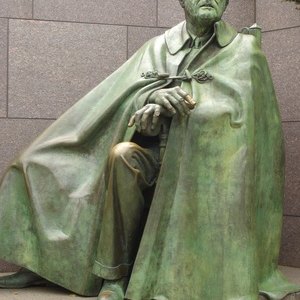
If the Great Depression, starting in late 1929, was not enough for American farmers, a massive and long-term drought hit America, creating the legend of the “Dust Bowl.” In response to this, the first 100 days of Franklin Delano Roosevelt's administration saw a flurry of legislation. The Emergency Farm Mortgage Act was passed in June of 1933, along with the closely related Farm Credit Act.
Background
American farms were going into foreclosure at an alarming rate from 1930 to 1933. A militant farmer's organization, the Farmers' Holiday Association, was formed to block roads and keep produce from getting to markets, starving the population until action was taken to save farms. It was an occasionally violent form of a “farmer's strike.” The association formed its own militia and shot at law enforcement. The Farmers' Holiday Association was one of the signs of American desperation, and FDR passed the Emergency Farm Mortgage Act in response, making $200 million immediately available for farms very close to foreclosure.
The Farm Credit Act
This act, passed in the same year, was institutionally necessary for the Emergency Farm Mortgage Act to take effect. The Farm Credit Act created a series of banks with specific roles. There were 12 banks forced to make quick, easy and low-cost loans to farmers, and another 13 dedicated to short- and medium-term loans for mortgages, refinance, marketing and production. Both the Emergency Farm Mortgage Act and the Farm Credit Act were brought under the authority of the Farm Credit Administration. While the administration continues its existence to the present day, the Emergency Farm Mortgage Act was de-funded in 1969, and formally repealed in 1971.
Loans
These agricultural initiatives were to replace the private banking sector that was unwilling or unable to assist farmers. All loans were government backed, and used for quick disbursement. Within 18 months, almost 20 percent of all agricultural property was being refinanced through the Emergency Farm Mortgage Act and the Credit Act.
Incentives and Schedules
As the 1930s wore on, many farms had been saved from liquidation by the Emergency Farm Mortgage Act and related acts. As produce prices continued to fall, especially with food aid being sent to Europe, farmers were encouraged to set aside land not to farm. The Supreme Court, in 1936, declared the Agricultural Adjustment Act of 1933 unconstitutional. This act had the government buy farmer's produce and distribute it in schools and to the poor. Congress then created the incentive plan to simply not farm. Farmers began to destroy their crops and kill piglets to keep farm prices up. In addition to these incentives to keep land fallow, FDR also had the Farm Credit Administration begin rescheduling loan repayments after the passage of the Emergency Farm Mortgage Act.
References
- "Reforming Farm Policy: Toward a National Agenda"; Willard Wesley Cochrane, Carlisle Ford Runge; 1992
- "The New Deal"; Fiona Venn; 1998
- Congressional Research Service. "Agriculture: A Glossary of Terms, Programs, and Laws, 2005 Edition," Page 97. Accessed Jan. 27, 2020.
- Internal Revenue Service. "Publication 225 Farmer's Tax Guide," Page 8. Accessed Jan. 26, 2020.
- Internal Revenue Service. "Schedule F (Form 1040 or 1040-SR) Profit or Loss from Farming," Pages 1-2. Accessed Jan. 26, 2020.
- Internal Revenue Service. "Publication 225: Farmer's Tax Guide," Pages 18-24. Accessed Jan. 27, 2020.
- Internal Revenue Service. "Publication 225: Farmer's Tax Guide," Pages 1-2. Accessed Jan. 26, 2020.
Writer Bio
Walter Johnson has more than 20 years experience as a professional writer. After serving in the United Stated Marine Corps for several years, he received his doctorate in history from the University of Nebraska. Focused on economic topics, Johnson reads Russian and has published in journals such as “The Salisbury Review,” "The Constantian" and “The Social Justice Review."

